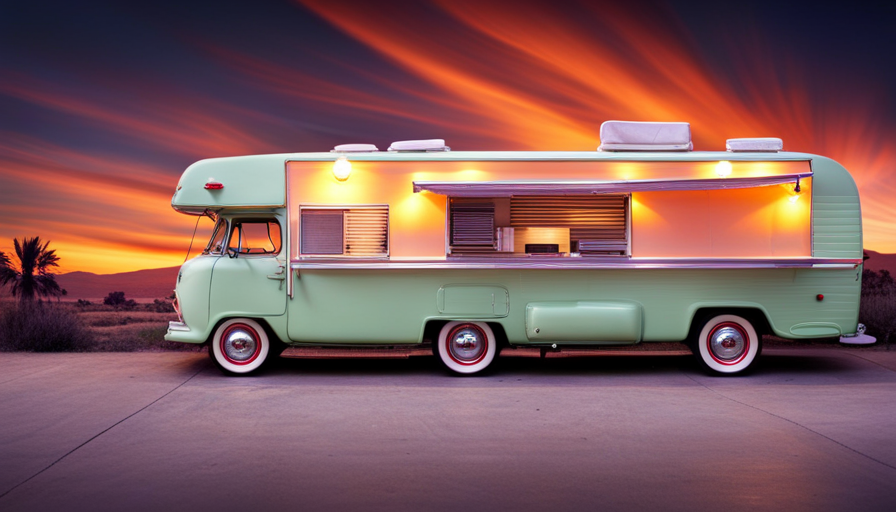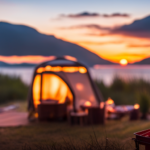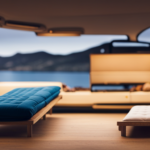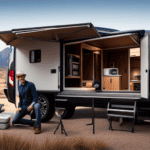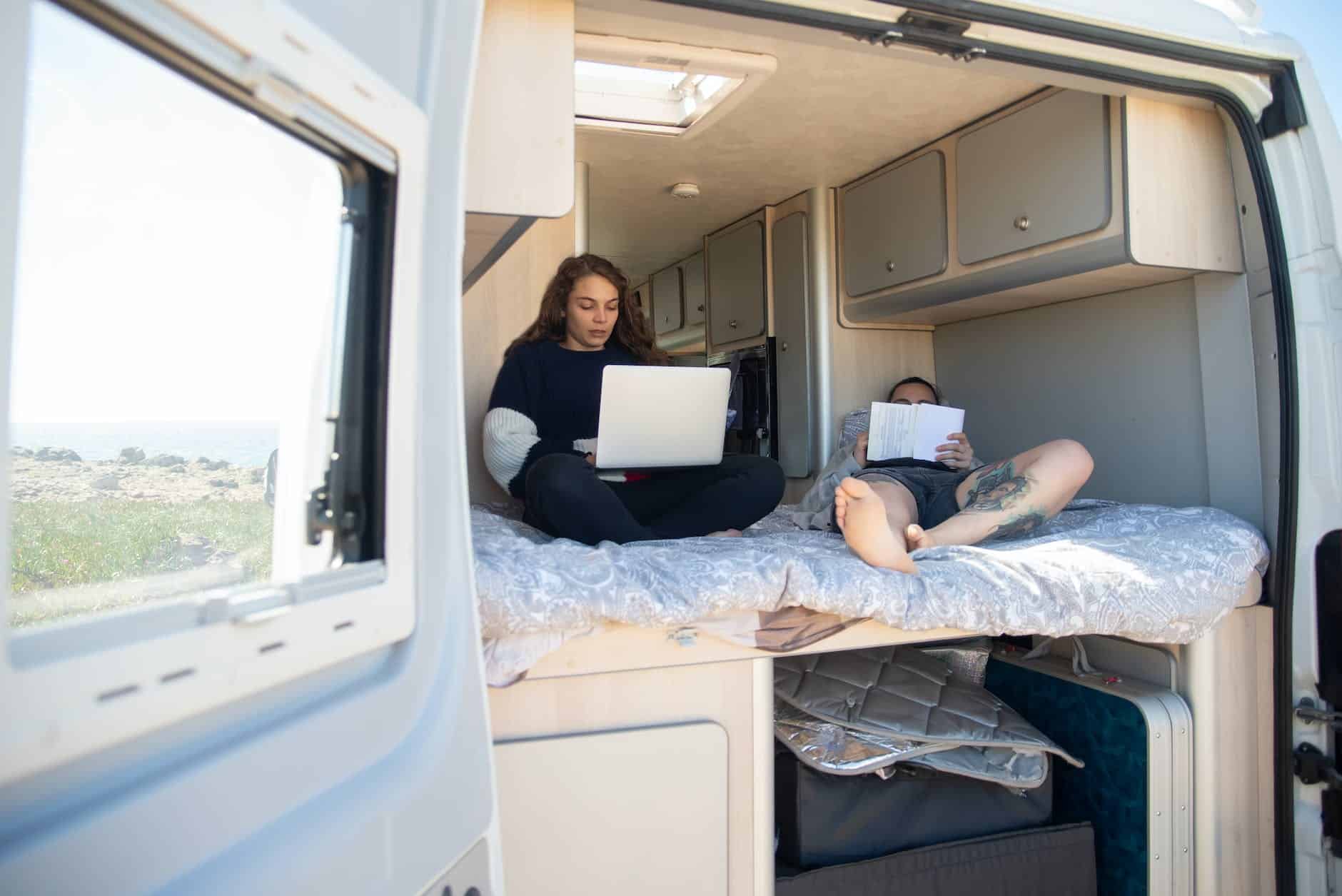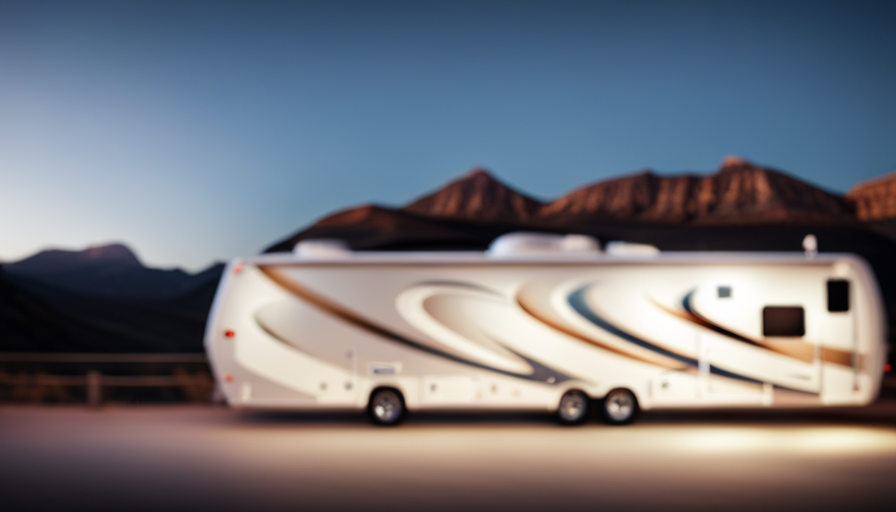So, you’ve made the bold choice to convert a simple camper into an impressive food truck? Well, my dear food lovers, fasten your seatbelts and get ready for an unparalleled journey!
In this guide, we’ll delve into the art of turning a simple camper into a mobile culinary haven that will leave mouths watering and taste buds tingling.
Picture this: a charming camper, once used for serene camping trips, now transformed into a vibrant hub of gastronomic delight. With our expert tips and tricks, you’ll learn how to choose the perfect camper, plan a layout that maximizes efficiency, and install all the necessary equipment and appliances to transform your mobile kitchen dreams into reality.
But wait, there’s more! We’ll also guide you through the important steps of ensuring proper ventilation and safety, creating a functional workspace, and implementing smart storage and organization solutions. And let’s not forget about the vital plumbing and electrical systems that will keep your food truck running smoothly.
So, my fellow food enthusiasts, prepare to embark on this culinary journey with us. Together, we’ll navigate the ins and outs of turning a camper into a food truck, obtain the necessary permits and licenses, and learn how to market your mobile culinary business to the masses. Get ready to satisfy appetites and make mouths water wherever you go!
Key Takeaways
- Selecting the right camper based on budget, size, and layout is crucial for a successful food truck transformation.
- Planning the layout and design of the food truck is important for efficiency and creating an ergonomic workspace.
- Ensuring compliance with health regulations and implementing safety measures, such as proper ventilation and fire suppression systems, is essential.
- Marketing strategies, including participating in outdoor events and utilizing social media, play a key role in attracting customers to the food truck.
Choose the Right Camper
Now, let’s dive into finding the perfect camper that’ll transform into your dream food truck!
Camper selection is a crucial step in the process of turning your camper into a food truck. When choosing a camper, there are a few things you should consider.
Firstly, think about your budget. Determine how much you’re willing to invest in your project. Remember, the cost of the camper itself is just the beginning. You’ll also need to factor in the cost of renovations, equipment, and permits.
Next, consider the size of the camper. Make sure it has enough space to accommodate all the necessary equipment and supplies for your food truck. You don’t want to end up with a cramped kitchen or limited storage space. Additionally, think about the layout of the camper. Does it have a functional floor plan that can easily be transformed into a food truck kitchen? Look for features like a sturdy frame, good insulation, and ample windows for natural light.
Once you’ve chosen the perfect camper, it’s time to plan your layout and design. This will be essential in creating an efficient and visually appealing food truck. So, let’s move on to the next section and explore how to plan your layout and design to make your food truck stand out from the crowd.
Plan Your Layout and Design
First, envision how you want your mobile eatery to look and feel, considering the overall layout and design. Creating an efficient workflow and ergonomic design is crucial for a successful food truck.
Start by mapping out the space and determining where each component will go. Consider the flow of food preparation, cooking, and serving to ensure a smooth operation.
When planning the layout, make sure to allocate enough space for food storage, preparation areas, cooking equipment, and a serving window. It’s important to optimize the available space while keeping functionality in mind. Utilize vertical storage options and multifunctional surfaces to maximize efficiency.
In terms of design, think about the ambiance you want to create. From color schemes to branding elements, every detail contributes to the overall experience. Incorporate your brand identity into the design, whether through signage, menus, or interior decor.
Remember to prioritize safety and compliance with health and safety regulations when designing your food truck layout. Install appropriate ventilation and fire suppression systems, as well as proper sanitation facilities.
Once you’ve planned your layout and design, it’s time to move on to the next step: installing essential equipment and appliances.
Install Essential Equipment and Appliances
To create a functional and efficient food truck, you’ll need to install essential equipment and appliances. Equipment selection plays a crucial role in determining the success of your food truck business. When choosing equipment, consider the type of cuisine you’ll be serving and the space available in your camper. Opt for high-quality, durable equipment that can withstand the demands of a mobile kitchen.
Some common equipment to include are grills, fryers, refrigerators, and prep tables.
Once you’ve selected the necessary equipment, it’s time to install them in your camper. Proper appliance installation is essential for smooth operation and safety. Pay attention to the manufacturer’s instructions and make sure each appliance is securely mounted or connected. This will prevent any accidents or malfunctions while on the road. It’s also important to consider the power requirements of your appliances and ensure that your camper’s electrical system can handle the load.
Now that you have your equipment and appliances installed, it’s crucial to ensure proper ventilation and safety measures. This includes installing an exhaust hood to remove heat, smoke, and odors from your cooking area. Additionally, fire suppression systems should be in place to prevent and control kitchen fires. By taking these precautions, you’ll create a safe and comfortable working environment for yourself and your staff.
Ensure Proper Ventilation and Safety Measures
Proper ventilation and safety measures are crucial for creating a safe and comfortable working environment in your food truck. It’s essential to ensure that your food truck has adequate ventilation systems in place to prevent the build-up of heat, smoke, and odors.
Here are three key items to consider when it comes to ventilation and safety:
-
Install a high-quality ventilation system: A reliable ventilation system will help remove smoke, steam, and cooking odors from your food truck. It’ll keep the air fresh and prevent the accumulation of harmful fumes, ensuring a healthy working environment for you and your staff.
-
Implement fire safety measures: Fire safety is of utmost importance in a food truck. Install fire extinguishers in easily accessible locations and ensure that they’re regularly inspected and maintained. Additionally, consider installing a fire suppression system specifically designed for small spaces like food trucks. This’ll provide an added layer of protection in case of a fire emergency.
-
Regularly inspect and maintain equipment: Conduct routine inspections to ensure that all ventilation systems and safety equipment are in working order. Clean the exhaust hood and filters regularly to prevent grease buildup, which’s a common fire hazard.
By incorporating these ventilation systems and fire safety measures, you can create a safe and comfortable working environment in your food truck.
In the subsequent section, we’ll discuss how to create a functional workspace in your transformed camper.
Create a Functional Workspace
Now, envision yourself stepping into your transformed mobile kitchen, where every inch of space is thoughtfully designed to create a functional and efficient workspace.
Efficiency is key when it comes to running a successful food truck, so designing an efficient workflow is crucial. Consider the layout of your equipment and workstations to minimize unnecessary movement and maximize productivity. Place your cooking appliances, prep areas, and storage strategically, ensuring easy access and smooth transitions between tasks. This ergonomic design will not only save you time but also reduce the risk of accidents and injuries.
When creating a functional workspace, it’s essential to prioritize organization and storage. Utilize vertical space by installing shelves, racks, and hooks to keep utensils, pots, and pans within reach. Invest in multipurpose equipment that saves space while still catering to your cooking needs. Additionally, consider using collapsible tables and workstations that can be easily stored when not in use. This will maximize your workspace and allow for flexibility.
As we transition into the next section about designing an eye-catching exterior, it is important to note that a well-designed workspace is not only functional but also visually appealing. By combining efficiency with creativity, you can create a mobile kitchen that’s both practical and visually enticing.
Design an Eye-Catching Exterior
Transforming your mobile kitchen involves not only creating a functional workspace but also designing an eye-catching exterior that will catch the attention of hungry customers.
The exterior of your food truck is the first thing people see, so it’s essential to make a memorable impression. One way to do this is by incorporating custom artwork that reflects your brand and menu. Consider hiring a professional artist to create a visually appealing design that showcases your unique style and personality. This artwork can be displayed on the sides, back, and even the roof of your truck, ensuring maximum visibility.
In addition to custom artwork, a well-thought-out branding strategy is crucial. Your food truck’s exterior should align with your overall brand identity, including your logo, colors, and font choices. Consistency in branding will help customers recognize and remember your truck amidst the sea of options.
When designing the exterior, think about how you can make it stand out from the crowd. Use vibrant colors, bold graphics, and attractive signage to draw attention. Consider incorporating elements that reflect the type of cuisine you offer, such as images of food or cultural symbols.
By creating an eye-catching exterior, your food truck will become a visually appealing and recognizable presence on the streets.
Now, let’s consider storage and organization to ensure a smooth operation.
Consider Storage and Organization
To ensure a smooth operation, it’s important to think about how we can efficiently store and organize our mobile kitchen. Storage solutions and maximizing space are crucial aspects of turning a camper into a food truck. With limited square footage, every inch needs to be utilized effectively.
One option for storage is to install shelves and cabinets. By utilizing vertical space, we can maximize the storage capacity of our food truck. Adjustable shelves allow us to customize the storage to fit our specific needs. Additionally, cabinets with doors can help keep things organized and prevent items from falling out during transit.
Another storage solution is the use of hooks and racks. These can be installed on the walls or inside cabinets to hang pots, pans, utensils, and other kitchen tools. Magnetic strips can also be mounted to store knives and other metal utensils, saving drawer space.
We should also consider incorporating storage compartments under counters and seats. These hidden spaces can be used to store supplies, ingredients, and equipment that are not needed on a regular basis.
By efficiently utilizing storage solutions and maximizing space, we can create a well-organized and functional mobile kitchen. With everything in its place, we can easily access what we need and keep our operations running smoothly. When it comes to the next step of installing plumbing and electrical systems, proper organization will ensure a seamless transition.
Install Plumbing and Electrical Systems
First things first, you’ll need to get the plumbing and electrical systems up and running in your mobile kitchen to ensure a smooth operation. Installing water and electricity is a crucial step in turning your camper into a fully functional food truck.
When it comes to plumbing, you’ll want to consider the layout and design of your kitchen. Determine where your sinks, water tanks, and wastewater tanks will be located. It’s important to choose high-quality pipes and fittings to ensure durability and prevent leaks. Don’t forget to install a water pump that can handle the demands of your kitchen.
In terms of electrical installation, you’ll need to plan out the placement of outlets, lighting fixtures, and appliances. It’s essential to hire a licensed electrician to ensure the safety and compliance of your electrical system. They’ll help you determine the appropriate wire sizes, circuit breakers, and grounding methods.
Once the plumbing and electrical systems are in place, you can move on to obtaining necessary permits and licenses. These permits will vary depending on your location, so it’s important to research and comply with local regulations.
By following these steps, you’ll be one step closer to transforming your camper into a fully operational food truck.
Obtain Necessary Permits and Licenses
Once you’ve completed the plumbing and electrical systems, it’s crucial to obtain the necessary permits and licenses, which play a vital role in the success of your mobile kitchen. Did you know that according to a survey, 73% of food truck owners reported that obtaining the correct permits and licenses was the most challenging aspect of starting their business?
To begin, you’ll need to navigate the permit application process. This typically involves filling out paperwork and submitting it to the appropriate local government agency. The specific requirements vary depending on your location, so it’s essential to research and understand the regulations in your area.
Some common permits include health department permits, fire safety permits, and zoning permits. Don’t forget to budget for any fees associated with the application process.
Additionally, you’ll need to meet the license requirements for operating a food truck. These requirements may include obtaining a business license, a food handler’s permit, and liability insurance. Again, the specific requirements vary by location, so be sure to thoroughly research what is needed in your area.
Once you’ve obtained all the necessary permits and licenses, you can move on to market your mobile culinary business. By promoting your unique menu, engaging with your target audience through social media, and participating in local events, you can attract customers and build a loyal following for your food truck.
Obtaining the correct permits and licenses is a crucial step in turning your camper into a successful food truck. By navigating the permit application process and meeting all license requirements, you can ensure that you’re operating legally and safely. With the necessary paperwork in hand, you can now focus on marketing your mobile culinary business and taking it to the next level.
Market Your Mobile Culinary Business
Now that we’ve obtained all the necessary permits and licenses, it’s time to showcase our culinary skills and captivate the taste buds of our potential customers. One way to do this is by participating in outdoor catering events. These events are a great opportunity to introduce our mobile culinary business to a large number of people in one place.
We can set up our food truck at local fairs, festivals, and markets, where people are already looking for unique and delicious food options. By offering a variety of mouthwatering dishes and providing excellent customer service, we can leave a lasting impression on attendees and turn them into loyal customers.
In addition to participating in outdoor events, social media marketing is an essential tool for promoting our mobile culinary business. We can create eye-catching posts and share enticing photos of our food on platforms like Instagram and Facebook. By engaging with our followers, responding to comments, and running promotions or giveaways, we can generate buzz and attract new customers.
It’s important to stay active on social media by regularly posting updates about our menu, upcoming events, and any special offers. By leveraging the power of social media, we can reach a wider audience and build a strong online presence for our mobile culinary business.
Frequently Asked Questions
How much does it cost to convert a camper into a food truck?
Converting a camper into a food truck can be an exciting project. When it comes to cost breakdown, it varies depending on factors like the size of the camper, equipment needed, and customization preferences.
For instance, a case study showed that a basic conversion could cost around $20,000, while a more customized one could reach $50,000. Common challenges include obtaining necessary permits, ensuring proper ventilation, and creating an efficient layout for food preparation and storage.
How long does it typically take to convert a camper into a food truck?
The conversion time for turning a camper into a food truck can vary depending on the complexity of the project and the specific requirements. However, there are several necessary steps involved in the process.
These steps include removing the interior of the camper, installing necessary equipment such as cooking appliances and refrigeration, modifying the exterior for serving windows and signage, and ensuring compliance with health and safety regulations.
Overall, the conversion process can typically take several weeks to a few months to complete.
What are the most important safety measures to consider when converting a camper into a food truck?
Food truck safety is of utmost importance when converting a camper into a food truck. Proper ventilation and fire safety measures, such as installing a commercial-grade exhaust hood and fire suppression system, are crucial.
Additionally, ensuring that all food truck equipment meets health and safety regulations, such as proper refrigeration and storage, is essential. Implementing proper food handling procedures and training staff on food safety practices will further ensure a successful and safe food truck operation.
Are there any specific regulations or guidelines that need to be followed when converting a camper into a food truck?
When converting a camper into a food truck, it’s crucial to adhere to specific regulations and guidelines set by local authorities. These ensure the safety and compliance of your food truck operation.
Regulations may cover areas such as food handling, sanitation, ventilation, fire safety, and electrical systems.
Guidelines may include requirements for equipment placement, signage, and accessibility.
By following these rules, you can create a food truck that meets all necessary standards while providing a unique dining experience.
How can I market my mobile culinary business effectively?
To market our mobile culinary business effectively, we should focus on effective social media and branding strategies.
Firstly, we need to establish a strong online presence by creating engaging content and regularly updating our social media accounts. This will help us reach a wider audience and attract potential customers.
Additionally, we can collaborate with local influencers or food bloggers to increase our visibility.
Lastly, we should prioritize consistent branding across all platforms to create a recognizable and memorable image for our business.
Can I Use the Same Storage Techniques for a Camper Turned Food Truck?
When converting a camper into a food truck, storing a camper effectively can be crucial for success. Utilize space-saving storage solutions such as built-in shelves, hanging racks, and stackable containers. Maximize every inch of space to ensure efficient organization and easy access to all your cooking and serving supplies.
Conclusion
As we embark on this journey of transforming a humble camper into a thriving food truck, we’re not just converting a vehicle, but turning dreams into reality.
Every step we take, from choosing the perfect camper to obtaining permits and licenses, is a symbol of our commitment and passion for culinary excellence.
This mobile culinary business is a testament to our creativity, attention to detail, and unwavering determination.
So join us as we hit the roads, spreading delicious aromas and flavors, and making our mark on the culinary world.

